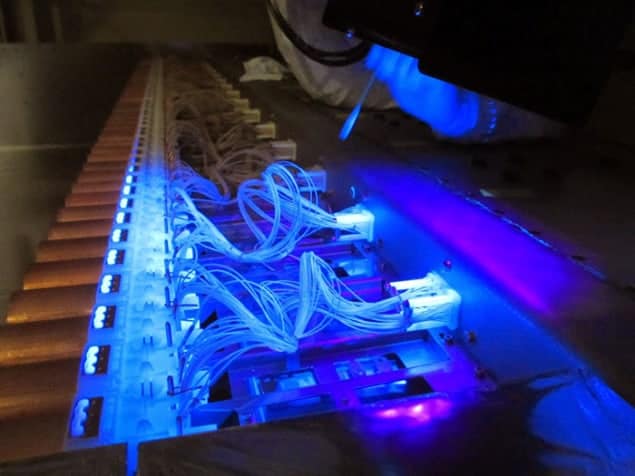
For the best part of 30 years, physicists have been looking for a very rare nuclear process known as neutrinoless double beta decay. With discovery still elusive, an international team of researchers led by Pawel Guzowski and colleagues at the University of Manchester have now turned their attention to an even rarer process called neutrinoless quadruple beta decay. As expected, their first search has drawn a blank. But they say it is worth persisting, given the potential prize on offer: an explanation for the universe’s matter/antimatter asymmetry.
In normal beta decay, an electron and an antineutrino are emitted from a nucleus within which a neutron transforms into a proton. There are also several dozen isotopes that have been shown to undergo double beta decay, in which two neutrons turn into two protons and emit two electrons plus two antineutrinos. But what physicists have been keen to observe, so far without success, is the neutrinoless version without the emission of any antineutrinos.
The discovery of this phenomenon, if real, would be huge news in physics, since it would defy the never previously violated conservation of lepton number – protons and neutrons having a lepton number of zero while electrons and neutrinos are +1 and their antimatter counterparts –1. Such a violation in turn might explain the dominance of matter over antimatter, since it would reveal a process that yields a slight excess of matter.
Majorana particles
Neutrinoless double beta decay would also mean that the neutrino is its own antiparticle, a so-called Majorana particle. This is because an antineutrino emitted by one of the two decaying neutrons could be absorbed by the other neutron as a neutrino, leading to no neutrino output. In contrast, the quadruple form of the decay would allow the neutrino to be a Dirac particle, like every other particle in the Standard Model, which is not the mirror image of itself.
Neutrinoless quadruple beta decay was proposed theoretically by Julian Heeck and Werner Rodejohann of the Max Planck Institute for Nuclear Physics in Heidelberg, Germany, in 2013. The pair found that by adding three right-handed neutrinos to the existing trio of left-handed neutrinos in the Standard Model, as well as two new scalar particles, which are similar to the Higgs boson, the (virtual) neutrinos emitted in the simultaneous beta decay of four neutrons would annihilate one another before they could be emitted from the nucleus in question.
“Before we published our paper the common opinion was that Dirac neutrinos conserve lepton number,” says Rodejohann. “We pointed out that Dirac particles can in fact violate lepton number, but by four units, say, rather than two.”
Energy boost
The Heidelberg researchers point out that the only nuclei that could undergo this decay are those for which the transformation of just one neutron into a proton boosts their energy – so forbidding normal beta decay, which would otherwise predominate – while the transformation of four neutrons makes them less energetic. They have identified just three such isotopes – zirconium-96, xenon-136 and neodymium-150 – of which the latter is best, they say, because it releases the greatest amount of energy during the decay, so making it more detectable.
Indeed, it is that nucleus that has been used in the Manchester-led research. The work was carried out at the NEMO-3 experiment at the Modane Underground Laboratory in France. This comprises a 3 × 5 m cylindrical detector consisting of thin foils of various isotopes – including 37 g of neodymium-150 – surrounded by tracking chambers and calorimeters. Although optimized to search for neutrinoless double beta decay, the detector’s ability to plot the trajectories of individual emitted particles also makes it well suited to the new line of research.
NEMO-3 has not collected new data, but rather physicists have analysed existing events recorded in its detector between 2003 and 2011. The researchers looked for events generating either three or four particles (in the former, one of the emitted electrons would be reabsorbed by the neodymium foil). Doing so, they found no evidence for events beyond those expected from background radioactive processes. But they were able to stipulate a first lower bound on the process’s half-life – some 1021 years.
Forty orders of magnitude
Steven Elliott of the Los Alamos National Laboratory in the US praises NEMO-3 for reaching “an interesting milestone that no other existing experiment can reach”. But he doubts that the group will be able to detect the putative decay, pointing out that Heeck and Rodejohann predicted a half-life (of around 1065 years) that is “at least 40 orders of magnitude” beyond the experiment’s sensitivity. Ettore Fiorini of the University of Milano-Bicocca shares that scepticism, arguing that a positive sighting “seems to be outside any realistic hope”.
Former NEMO-3 member Xavier Sarazin of the Linear Accelerator Laboratory in Orsay, France, acknowledges that the group is very unlikely to make a discovery. But he maintains that it will still be worthwhile carrying out a new search with the upgraded “SuperNEMO”, which should start taking data in about a year and which could contain up to a kilogram of neodymium-150. “You would never design an experiment from scratch to look for this decay,” he says, “but if you can increase the amount of neodymium, why not?”
Indeed, Heeck says that potential alternatives to the model developed by himself and Rodejohann might feature much shorter decay half-lives. “Our hope would be that NEMO-3’s first experimental search for quadruple beta decay will motivate people to explore models that could lead to testable rates,” he says.
The research has been accepted for publication in Physical Review Letters and a preprint is available on arXiv.



